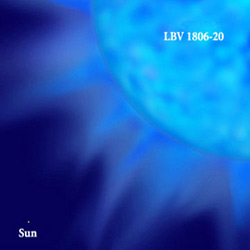
With a diameter of at least 200 times the Sun's and a mass of roughly 150 solar masses, the luminous blue variable known as LBV 1806–20 could be the most massive and perhaps the most luminous star ever discovered.
Courtesy Steve Eikenberry.
There’s a new contender for the title of the most extreme known star. At the January meeting of the American Astronomical Society (AAS), Stephen Eikenberry (University of Florida) claimed to have found the most massive and perhaps the most luminous star yet discovered.
The star is a luminous blue variable known as LBV 1806–20 for its celestial coordinates in northern Sagittarius. It's located some 45,000 light-years away on the far side of the Milky Way; intervening dust clouds obscure it from view at visible wavelengths of light. But in infrared light it shines through, and so do its surroundings. Eikenberry and a team of 16 other astronomers and graduate students find that the star emits between 5 million and 40 million times as much energy as the Sun. This probably edges out the previous record holders, Eta Carinae with 3 to 5 million solar luminosities, and the Pistol Star (so called for its location in the Pistol Nebula near the galactic center), which shines with the brightness of 5 or 6 million Suns.
The infrared spectrum of LBV 1806–20 gives its rough temperature: 18,000° to 32,000° Kelvin. Its diameter works out to at least 200 times the Sun's, and its mass should amount to at least 150 solar masses — perhaps more. That ought to make stellar theorists look up and take notice. No star can survive with more than about 100 or 120 solar masses, according to theory that has been well established for much of the last century. The more massive a star is, the greater its luminosity, and a star above that mass limit should be so bright that its own radiation pressure blows away much of its bulk. Eikenberry proposes that LBV 1806–20 is a very young star in the process of doing exactly that.
Its close neighbors seem to be giving away clues. LBV 1806–20 exists in a smallish group of other very young and massive stars. Its neighbors include three rare Wolf-Rayet objects (very hot stars that have blown off their outer hydrogen layers), a massive star that's currently forming deep inside a clump of dust, and a neutron star left over from a supernova. Eikenberry suggests that the supernova explosion may have compressed a dense cloud of interstellar matter especially violently and triggered a star-birth spasm of extraordinarily massive stars.
Past candidates for supermassive stars have sometimes turned out to be tight, unresolved clusters of more ordinary suns. But a speckle-interferometry study with the 200-inch Hale telescope on Palomar Mountain has ruled out that possibility here, said Eikenberry at the meeting. The star could still be an unresolved double or triple, which would bring down its dramatic vital statistics. But that seems unlikely because some of its spectral features change brightness rapidly by up to a factor of five, says Eikenberry, "which suggests that most of the light is coming from one place."
 0
0
Comments
You must be logged in to post a comment.